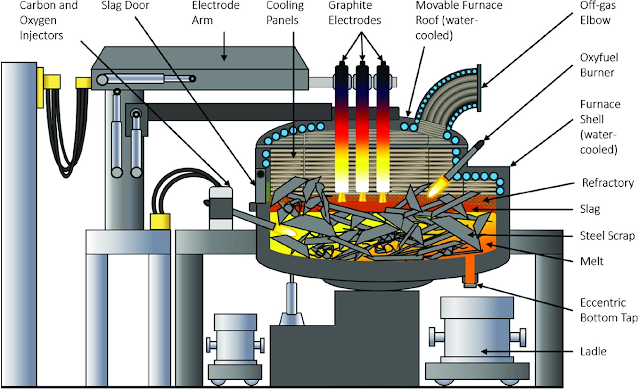Transformers for Electric Arc Furnaces (Metal Furnaces)
In this chapter, we will discuss a special application of transformers, which are used in furnaces and whose purpose is to create arcs in alternating current.
An electric arc furnace (metal furnace) melts the metal in the furnace by creating an electric arc between the feed plates of the furnace directly through the material we want to melt. The enormous heat generated caused the entire contents of the oven to melt. These furnaces are characterized by very high currents, ranging from 100 kA to 300 kA, and relatively low voltages of 150 to 2,500 volts. Due to the high power required for furnaces from 10MVA to 100MVA and even higher, and the nature of the load, transformers are fed from high voltage networks or high voltages very close to 1000MV to ensure that disturbances in the network during use remain acceptable according to the standard Level.
Furnace duty cycles vary widely depending on furnace size and job requirements, with typical duty cycles in the 3-8 hour range. The first step in the process is the melting process. During this process, the metal enters the furnace in a solid state, so it takes a lot of energy to melt it and turn it into a liquid. The second part of the process is called the distillation step. During this phase, the temperature in the oven remains constant and the energy provided is only used to compensate for heat loss in the oven. The melting stage is characterized by large current fluctuations caused by the instability of the arc due to the movement of the material in the furnace and its properties, and this stage continues until all materials in the furnace are homogeneously melted. During the distillation stage, the current fluctuations are much smaller because all the material is melted. Current fluctuations in the melting phase are controlled to some extent by furnace design, transformer, and load type. For example, finely shredded scrap produces much less vibration than larger, non-uniform scrap.
In order to characterize the transformer, it is necessary to understand how the furnace works and its operating cycle. The effect of peak loads during the melting phase must be carefully considered when selecting a suitable transformer, assuming that the load will be significantly reduced during the refining phase. At the beginning of a melting cycle, the load on the transformer can be as high as twice its normal and continuous load.
Because the low-voltage side windings of transformers designed for furnaces require high currents, engineering problems caused by the rapidly changing nature of the load must be overcome. The cross-sectional area of the winding on the medium and low voltage sides of the transformer should be large, and the number of windings required should be small. In most cases, the coils on the secondary side are delta-connected to reduce phase currents and achieve good electromagnetic balance and high mechanical strength. Low-voltage coils are usually constructed of pairs of parallel disks mounted outside the transformer to help cool them. Since these types of transformers generate enormous amounts of heat, the cooling method for these transformers is OFWF, which means circulating the oil and cooling it using a water-injected heat exchanger.
A high-impedance transformer design helps limit the power of the current surge and minimize its impact on the supply network, but too high a value will reduce the short-circuit power of the furnace, thereby increasing the cycle time of the melt. However, the transformer coils are repeatedly subjected to severe mechanical shocks during melting, thus requiring particularly durable mechanical reinforcement of the coil structure. Care must be taken to maintain the space between the coils and the support points and secure them securely to ensure that constant shock to them does not cause them to loosen or move.
Radial support for the coils is provided by insulating paper holding the conductors, and the coils themselves are made of a silver-copper alloy designed to provide maximum strength and stiffness. The transformer tank must also be reinforced to provide maximum stiffness and withstand the electrical power generated in the transformer.
Another furnace characteristic that transformer designers must be aware of is the widely varying voltage drop during the melting phase. In order to maintain an active arc that does not subside during the melting stage, a voltage much greater than that required for the refining stage is required. Achieving balance requires precise control of the furnace current. Therefore, it is important to control the voltage carefully.
Another problem faced by transformer designers is that in order to produce good current control on the low voltage side, a step change is required on the high voltage side of the transformer, so the transformer must include a step change in the load that involves a large number of steps.
The specification of step converters for transformers for electric arc furnaces are particularly demanding in terms of current, the number of steps, the large number of operations, and response speed. Therefore, the tap-changer must have very high reliability to ensure a fast response in variable load or overload situations. Shifters require a lot of maintenance and frequent maintenance to ensure their integrity for long working hours in these tough working conditions.
Free send inquiries to stella@hanrm.com or inquiry99@hanmetallurgy.com if any needs.
Email: stella@hanrm.com Or stellarollingmill@gmail.com inquiry99@hanmetallurgy.com
Whatsapp/Wechat:+8615877652925
Website: https://www.hanmetallurgy.com/



.jpg)








没有评论:
发表评论